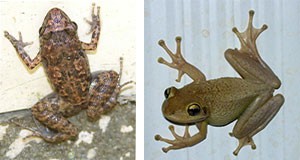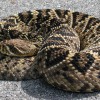 Frogs control garden pests such as insects and slugs and serve as a food source for many larger wildlife species. Research on the substances frogs secrete through their skins has even led to the creation of new painkillers and antibiotics. Most frogs in Florida are reclusive and harmless to people, but two species of frogs that have invaded Florida can be harmful to humans and their pets. This 4-page fact sheet presents some facts about native frogs, describes the problems invasive frogs cause, and provides suggestions on how to cope with problem frogs. Written by Steve Johnson, Holly K. Ober, and William M. Giuliano, and published by the UF Department of Wildlife Ecology and Conservation, November 2014. (Photos: Steve Johnson, UF/IFAS)
Frogs control garden pests such as insects and slugs and serve as a food source for many larger wildlife species. Research on the substances frogs secrete through their skins has even led to the creation of new painkillers and antibiotics. Most frogs in Florida are reclusive and harmless to people, but two species of frogs that have invaded Florida can be harmful to humans and their pets. This 4-page fact sheet presents some facts about native frogs, describes the problems invasive frogs cause, and provides suggestions on how to cope with problem frogs. Written by Steve Johnson, Holly K. Ober, and William M. Giuliano, and published by the UF Department of Wildlife Ecology and Conservation, November 2014. (Photos: Steve Johnson, UF/IFAS)
http://edis.ifas.ufl.edu/uw394
Tag: Steven A. Johnson
Managing Conflicts with Wildlife: Living with Snakes
 Snakes provide numerous benefits to people and to the environment, by controlling rat and mice populations in the environment, for example. Or in the laboratory, where pygmy rattlesnake venom research helped develop medicine to thin the blood of heart attack patients. Most snakes are secretive and rarely bother people, but there are situations where some snakes can become dangerous. In this 4-page fact sheet, we present some facts about snakes, describe dangers they may cause, and provide suggestions on how to cope with these dangers. Written by Holly K. Ober, Steve Johnson, and William M. Giuliano, and published by the UF Department of Wildlife Ecology and Conservation, November 2014. (Photo: Steve Johnson)
Snakes provide numerous benefits to people and to the environment, by controlling rat and mice populations in the environment, for example. Or in the laboratory, where pygmy rattlesnake venom research helped develop medicine to thin the blood of heart attack patients. Most snakes are secretive and rarely bother people, but there are situations where some snakes can become dangerous. In this 4-page fact sheet, we present some facts about snakes, describe dangers they may cause, and provide suggestions on how to cope with these dangers. Written by Holly K. Ober, Steve Johnson, and William M. Giuliano, and published by the UF Department of Wildlife Ecology and Conservation, November 2014. (Photo: Steve Johnson)
http://edis.ifas.ufl.edu/uw395
Buyers’ Guide to Pet Reptiles (WEC312/UW357)
 When choosing a pet reptile, there are some important questions you should consider.This 3-page fact sheet will provide you with some basic information about reptiles and their care, in order to help you choose an appropriate reptile pet that will suit your lifestyle. Written by Steve A. Johnson, Monica E. McGarrity, and Dustin Smith , and published by the UF Department of Wildlife Ecology and Conservation, August 2011.
When choosing a pet reptile, there are some important questions you should consider.This 3-page fact sheet will provide you with some basic information about reptiles and their care, in order to help you choose an appropriate reptile pet that will suit your lifestyle. Written by Steve A. Johnson, Monica E. McGarrity, and Dustin Smith , and published by the UF Department of Wildlife Ecology and Conservation, August 2011.
http://edis.ifas.ufl.edu/uw357
Quick Reference Guide: Large Lizards in Florida (WEC307/UW352)
The non-native lizards breeding in Florida now outnumber the native species, and there are several large, invasive lizards that are of special concern. This quick reference guide is a quick reference guide to identification of the largest lizards you are likely to see in Florida, and the appropriate action to take in the event of an encounter. Written by Steve A. Johnson and Monica E. McGarrity and published by the UF Department of Wildlife Ecology and Conservation, March 2011.
http://edis.ifas.ufl.edu/uw352
Quick Reference Guide: Native Snakes Easily Mistaken for Introduced Constrictors in Florida (WEC305/UW350)
Three non-native species of large constrictor snakes are now breeding in Florida, and several others have been encountered but have not yet established wild populations. This quick reference guide to identification of the native snakes you might easily mistake for introduced constrictors in Florida was written by Steve A. Johnson and Monica E. McGarrity, and published by the UF Department of Wildlife Ecology and Conservation, Januar 2011.
http://edis.ifas.ufl.edu/uw350
Options for Unwanted Exotic Pets (WEC308/UW353)
Exotic reptiles, birds, and fish are popular pets. However, many species grow large and require special cages or become difficult to handle. If at some point you are no longer able to care for your exotic pet, you have several options that are discussed in this brochure, written by Steve A. Johnson, Monica E. McGarrity, and Dustin Smith, and published by the UF Department of Wildlife Ecology and Conservation, March 2011.
http://edis.ifas.ufl.edu/uw353
Florida Invader: Cuban Treefrog (WEC301/UW346)
Do you now how to tell the difference between an invasive Cuban Treefrog and a native treefrog? This 2-page fact sheet will help you correctly identify and humanely euthanize this invasive frog that preys on several species of native tree frogs. It was written by Steve Johnson and Monica McGarrity, and published by the UF Department of Wildlife Ecology and Conservation, November 2010.
http://edis.ifas.ufl.edu/uw346
Florida Invader: Common Boa (WEC297/UW342)
Sightings of this large, nocturnal predator that may grow to 15 feet long and kills its prey by constriction, established in Miami, should be reported immediately to 1-888-IveGot1 or www.IveGot1.org. This 2-page fact sheet written by Steve Johnson and Monica McGarrity provides pictures and information to aid identification. Published by the UF Department of Wildlife Ecology and Conservation, February 2011.
http://edis.ifas.ufl.edu/uw342
Possible Florida Invader: Ball Python (WEC296/UW341)
Sightings of this nocturnal predator that is usually only three to four feet long, not established in Florida but very common in the pet trade, should be reported immediately to 1-888-IveGot1 or www.IveGot1.org. This 2-page fact sheet written by Steve Johnson and Monica McGarrity provides pictures and information to aid identification. Published by the UF Department of Wildlife Ecology and Conservation, February 2011.
http://edis.ifas.ufl.edu/uw341
Florida Invader: Cane Toad (WEC300/UW345)
Do you now how to tell the difference between a dangerous Cane Toad (a.k.a. “Bufo” Toad or Marine Toad) and a harmless native toad? This 2-page fact sheet will help you correctly identify and humanely euthanize this invasive toad that can kill pets. It was written by Steve Johnson and Monica McGarrity, and published by the UF Department of Wildlife Ecology and Conservation, November 2010.
http://edis.ifas.ufl.edu/uw345
Florida Invader: Tegu Lizard (WEC295/UW340)
Sightings of this large black-and-white invasive lizard, established in areas southeast of Tampa and south of Miami, should be reported immediately to 1-888-IveGot1 or www.IveGot1.org. This 2-page fact sheet, written by Steve Johnson and Monica McGarrity provides pictures and information to aid identification. Published by the UF Department of Wildlife Ecology and Conservation, November 2010.
http://edis.ifas.ufl.edu/uw340
WEC302/UW347 Quick Reference Guide: Introduced Constrictors in Florida
WEC302, a 2-page fact sheet by Steve A. Johnson and Monica E. McGarrity, is a quick reference guide to identification of the constrictors one is most likely to encounter in Florida. Published by the UF Department of Wildlife Ecology and Conservation, November 2010.
http://edis.ifas.ufl.edu/uw347
WEC294/UW339 Possible Florida Invader: Reticulated Python
WEC294, a 2-page illustrated fact sheet by Steve Johnson and Monica McGarrity, describes this native to southeastern Asia which has been found in the wild but is not established in Florida, how to identify and report sightings. Published by the UF Department of Wildlife Ecology and Conservation, November 2010.
http://edis.ifas.ufl.edu/uw339
WEC293/UW338 Florida Invader: Nile Monitor Lizard
WEC293, a 2-page illustrated fact sheet by Steve Johnson and Monica McGarrity, describes this native to sub-Saharan Africa with isolated populations in Broward and Miami-Dade Counties, with information on how to identify them and report sightings. Published by the UF Department of Wildlife Ecology and Conservation, November 2010.
http://edis.ifas.ufl.edu/uw338
WEC290/UW335 Possible Florida Invader: Yellow Anaconda
WEC290, a 2-page illustrated fact sheet by Steve Johnson and Monica McGarrity, is part of the Florida Invaders series. It provides key information and illustrations for identifying and reporting sightings of this large nocturnal predator that is native to tropical South America and is not established in Florida, but escaped or released pets have been encountered in the wild. Published by the UF Department of Wildlife Ecology and Conservation, August 2010.
http://edis.ifas.ufl.edu/uw335
WEC289/UW334 Possible Florida Invader: Green Anaconda
WEC289, a 2-page illustrated fact sheet by Steve Johnson and Monica McGarrity, is part of the Florida Invaders series. It provides key information and illustrations for identifying and reporting sightings of this large nocturnal predator that is native to tropical South America and is not established in Florida, but escaped or released pets have been encountered in the wild. Published by the UF Department of Wildlife Ecology and Conservation, August 2010.
http://edis.ifas.ufl.edu/uw334
WEC288/UW333 Florida Invader: Burmese Python
WEC288, a 2-page illustrated fact sheet by Steve Johnson and Monica McGarrity, is part of the Florida Invaders series. It provides key information and illustrations for identifying and reporting sightings of this large nocturnal predator that is native to Southeast Asia and is now established and breeding in Florida and Puerto Rico. Published by the UF Department of Wildlife Ecology and Conservation, August 2010.
http://edis.ifas.ufl.edu/uw333
WEC287/UW332 Florida Invader: African Python
WEC287, a 2-page illustrated fact sheet by Steve Johnson and Monica McGarrity, is part of the Florida Invaders series. It provides key information and illustrations for identifying and reporting sightings of this large nocturnal predator that is native to sub-Saharan Africa but may be breeding in Florida. Published by the UF Department of Wildlife Ecology and Conservation, August 2010.
http://edis.ifas.ufl.edu/uw332
WEC218/UW259: The Cuban Treefrog (Osteopilus septentrionalis) in Florida
Revised! WEC218, an 8-page fact sheet by Steve A. Johnson, describes this member of the frog family Hylidae which is invasive to Florida, how to identify it, its ecology and natural history, its impact in Florida, and what homeowners can do to manage Cuban treefrogs around their home. Includes additional resources. Published by the UF Department of Wildlife Ecology and Conservation, August 2010.
http://edis.ifas.ufl.edu/uw259
WEC292/UW337 Introduced Reptile Early Detection and Documentation Training: Instructor Guide
WEC292, a 5-page illustrated fact sheet by Steve Johnson and Monica McGarrity, familiarizes trainers with the REDDy program and provides the resources necessary for presenting the course concept and basic instructions to potential trainees and answering their questions. Published by the UF Department of Wildlife Ecology and Conservation, August 2010.
http://edis.ifas.ufl.edu/uw337